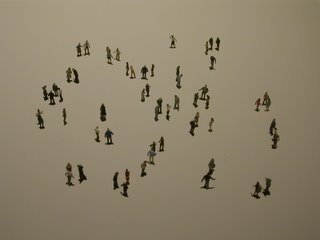
variations on a theme
The only two dance performances I've ever seen and not liked were a jazz tap show (when I was working as an usher) and a performance by the New York City Ballet. I could appreciate the dancers' skills, but the whole production felt stilted, as if an entire range of emotion and movement were off-limits because of a set of antiquated instructions on what dance should be. But I got goosebumps at the Mark Morris ballet this afternoon.
Imagine you are Mark Morris. Let's say you are moved by baroque classical music. How do you choreograph a piece that communicates this to the audience? The phrase "baroque classical" doesn't tell people much these days, and hearing the actual music is probably worse. For one thing, it's too culturally-coded: you immediately think of those lone stations on the radio dial with the sedate hosts and tasteful commercials for uspcale furnishings stores. (In Baltimore, my local car-repair guys dressed in white lab coats, had Wall Street Journals lying around the waiting area, and played the classical music stations on the radio so white-collar folks would think I can trust these guys and would gladly pay the jacked-up prices.) And what do you do with the delicate and refined movements we automatically associate with, say, trembling flute melodies? There are whole genres of Hollywood movies that parody these dances and their leotards.
One way to defuse the expectations is to play to them; at times Morris pokes fun at the genre by giving his dancers exaggerated, goofy movements (although there are also plenty of straight-up precious-graceful-bird-like movements set to flute and soprano solos). Then there are moments of slapstick, such as the two rings of male dancers, the outside ring spanking the inside ring along. But mostly Morris runs with what the music does best: set up intricate structures and vary them. I have only a vague idea of what the term counterpoint means, but I feel like for two hours Morris created it physically in flesh and blood, dressed it in color, and whirled it around.
When most or all of the twenty-five dancers were on stage, you felt you were looking through an old-fashioned kaleidoscope. At one point, two lines of dancers snake around the stage, outlining the corners of a square, then cross the stage diagonally to meet, touch briefly, and bump off to the edge again--a perfect abstraction, like a screen-saver or those "serpent" games on your old computer's hard-drive. In the next-to-last sequence, the dancers sprinted and skipped full-speed towards the audience then veered offstage, to sprint and skip another pass, always in different teams of two and three. (Goosebumps.) And Morris always allows these precisely coordinated sequences to break down, wander off-course, become human again. From where I was sitting, high above the action, and because it's been on my mind, sometimes it looked like people crossing a train station or public plaza.
And then Molly re-enacted whole scenes out on Tremont Street after the show. Morris would've loved it.


1 Comments:
Dude's a genius from way back.
Post a Comment
<< Home